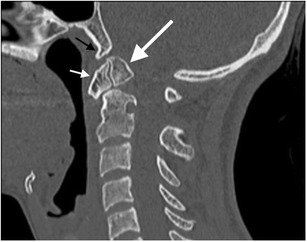Fig. 10.

Os odontoideum: sagittal reformatted CT image of the craniocervical junction performed as part of a trauma CT assessment of a young female victim of a fall from height demonstrates a pre-existing os odontoideum (large white arrow) mimicking a type II odontoid process fracture. While the (type II) odontoid fracture is typically associated with a flattened uncorticated sharp margin to the adjacent body of the axis and a normal morphology to the anterior arch of the atlas, the os odontoideum exhibits a well-corticated convex upper margin. A commonly associated rounded hypertrophic anterior atlas arch is also present (small white arrow). This, together with an associated condylus tertius (small black arrow) which represents a remnant hypochordal bow, further confirms the non-acute traumatic aetiology of the odontoid process appearances
